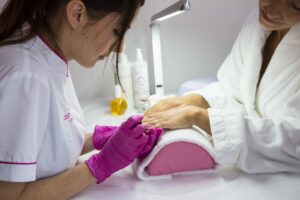NIOSH: Health & Workplace Exposure Control
According to the The National Institute for Occupational Safety and Health (NIOSH), Nail salon employees are potentially exposed to dozens of chemicals including acrylates, solvents, and biocides as dusts or vapors.
A small but growing number of studies have examined possible links between nail technicians’ work and health outcomes, such as respiratory, neurological, and musculoskeletal effects, as well as other health conditions.
Nail technicians perform manicures and may also perform pedicures. Manicures are performed over a workstation with the client’s hands resting on the table as they work, and therefore, directly below the nail technicians’ breathing zone.

Downdraft vented nail tables provide the means to vent (remove) potential dust or chemicals away from the breathing zone, and theoretically, potential contaminants may be removed before they cross the breathing zone and are inhaled.
The application of artificial fingernails is the nail technician’s highest breathing hazard.
Artificial fingernail products are made from many chemicals, but the main one in most of these products is ethyl methacrylate (EMA). It can cause contact dermatitis, asthma, and allergies in the eyes and nose, all problems that nail technicians know about.
In the nail salon, to get rid of EMA in the air you breathe, you should apply artificial fingernails at a ventilated work table. It is also helpful to keep all bottles of fingernail liquid tightly capped.

Keep dispenser bottles closed. Use dispenser bottles that have small openings, only large enough for an application brush to enter. The bottle stoppers should be pressure sensitive. A dispenser bottle with a pressure-sensitive stopper and small opening will result in less evaporation of the fingernail liquid and, thus, will cut down on possible exposures to methacrylate.

Nail technicians perform manicures and may also perform pedicures. Exposures may differ, though, as pedicures involve processes such as soaking feet, filing calluses, and the use of pedicure work stations, but do not typically involve artificial nail application.
